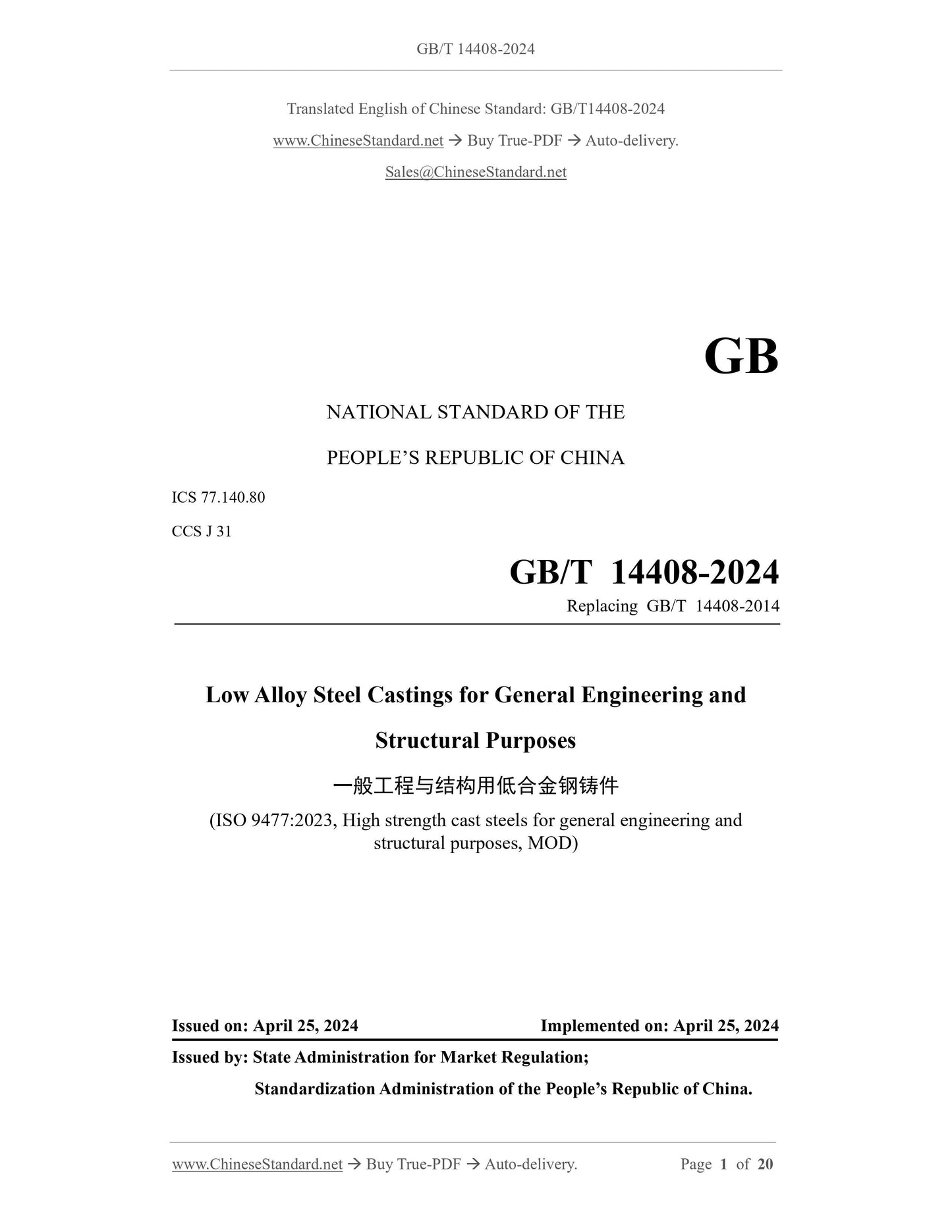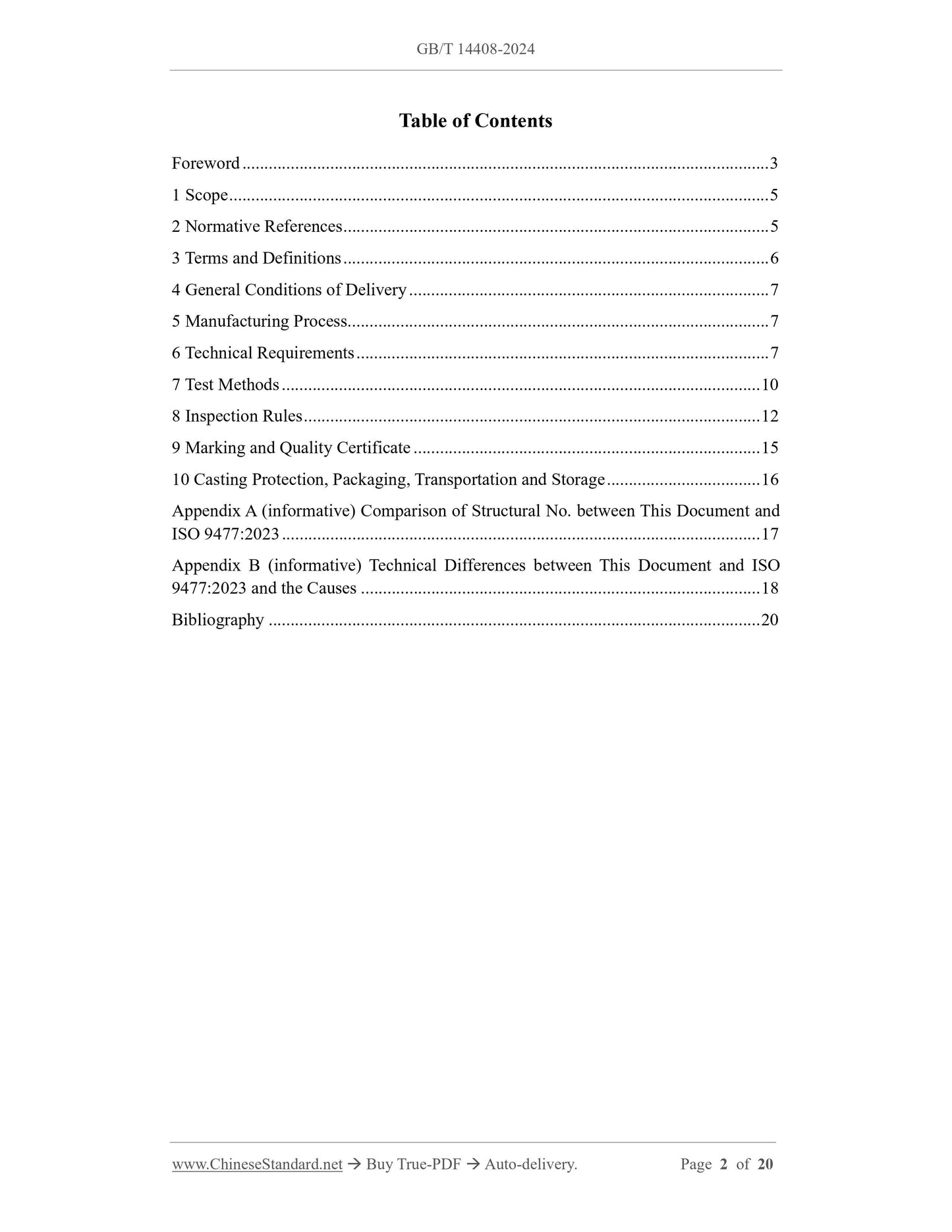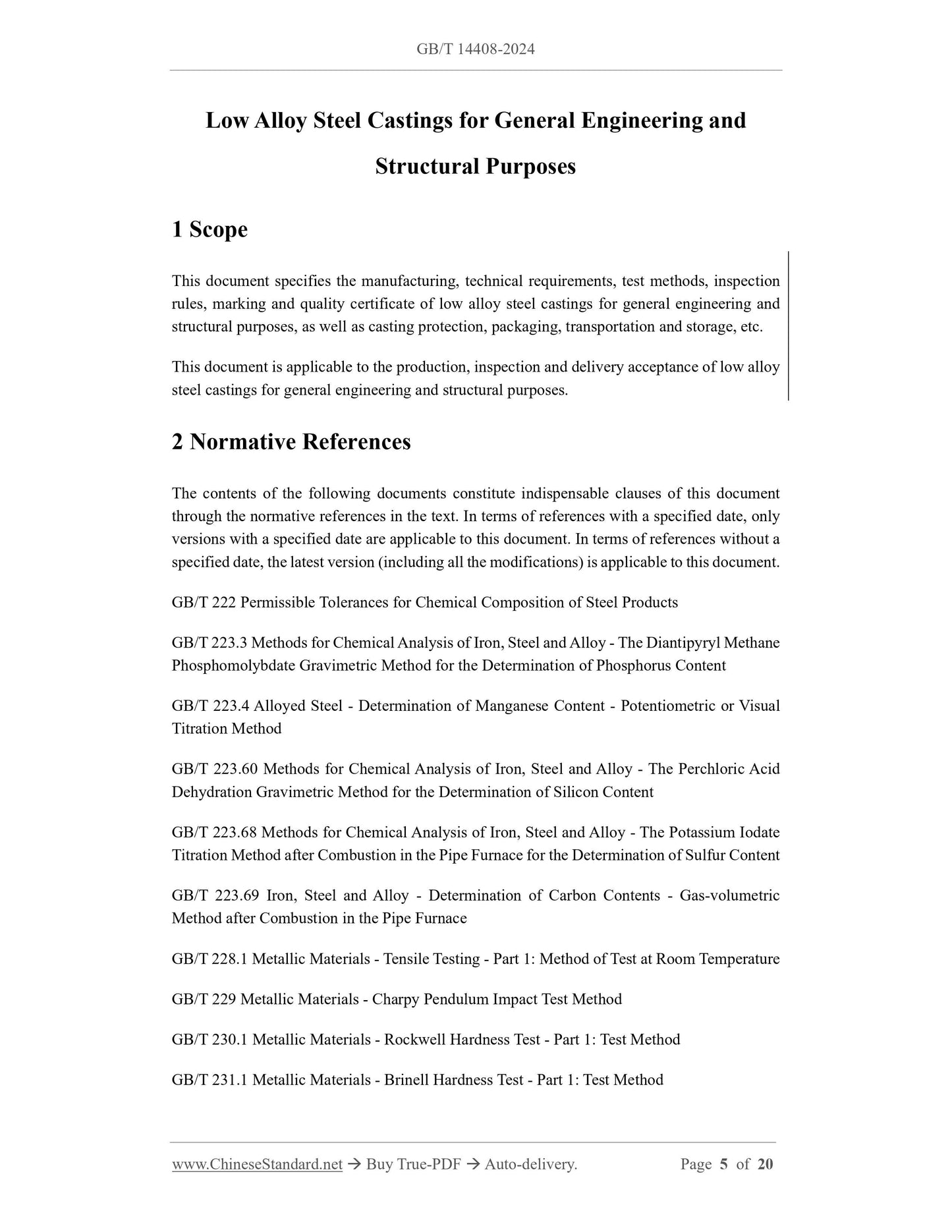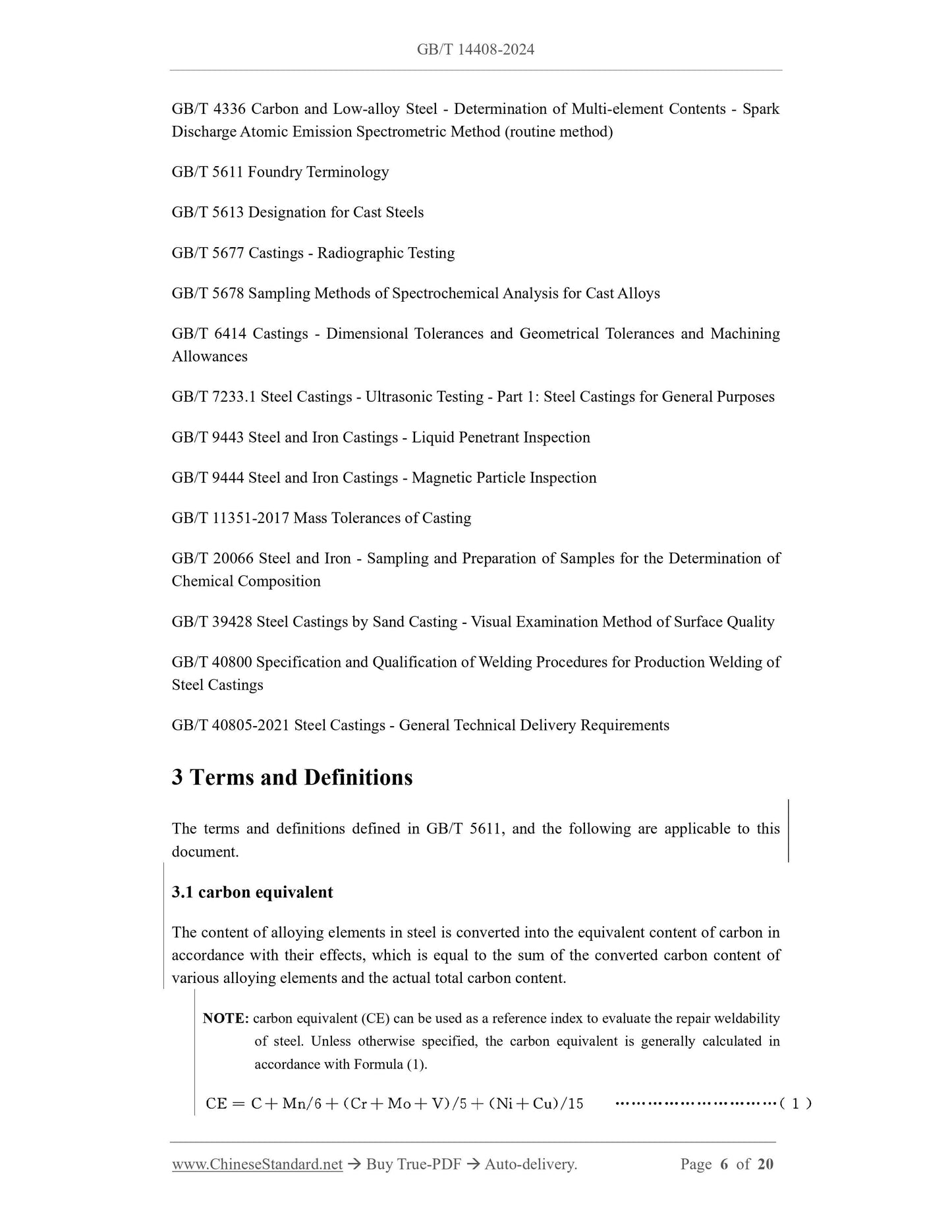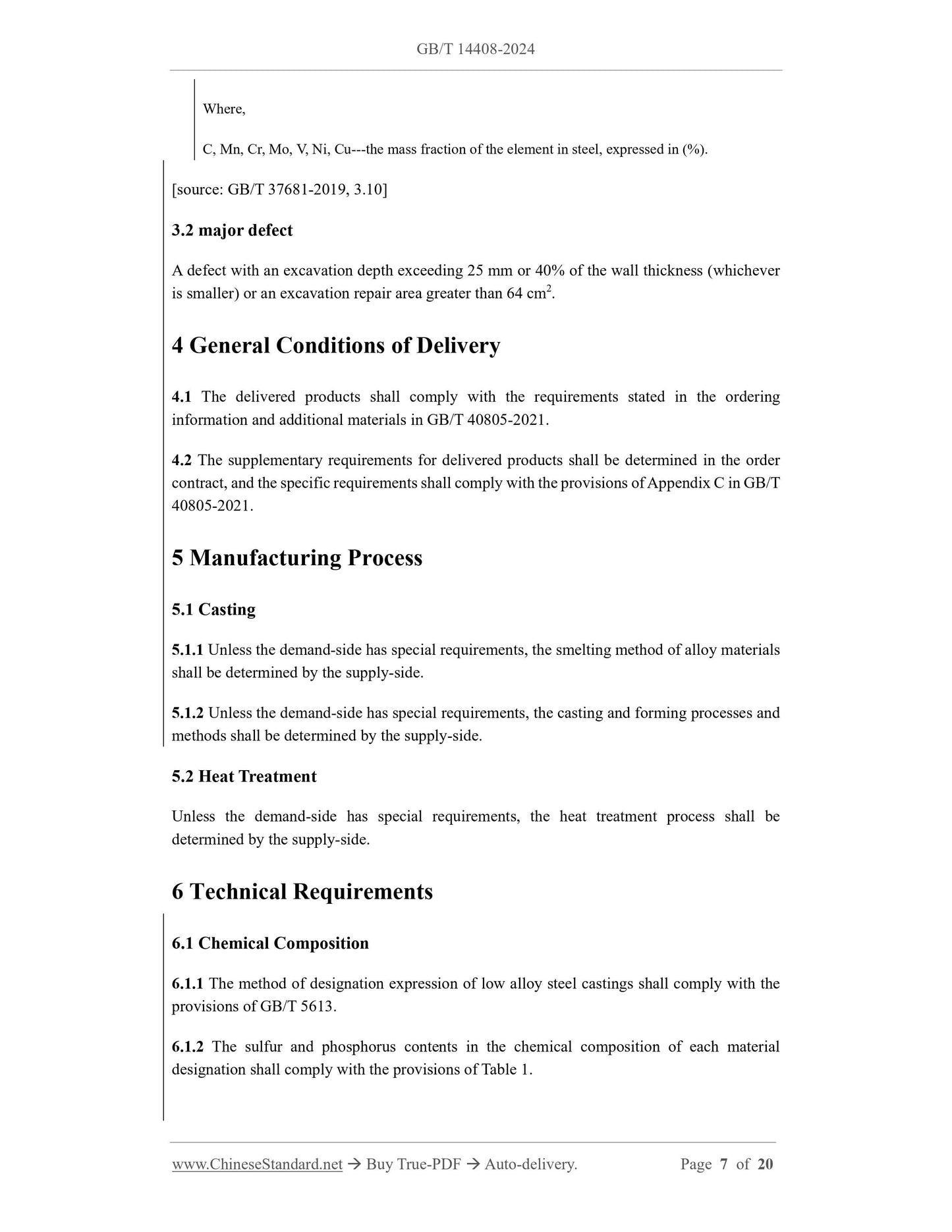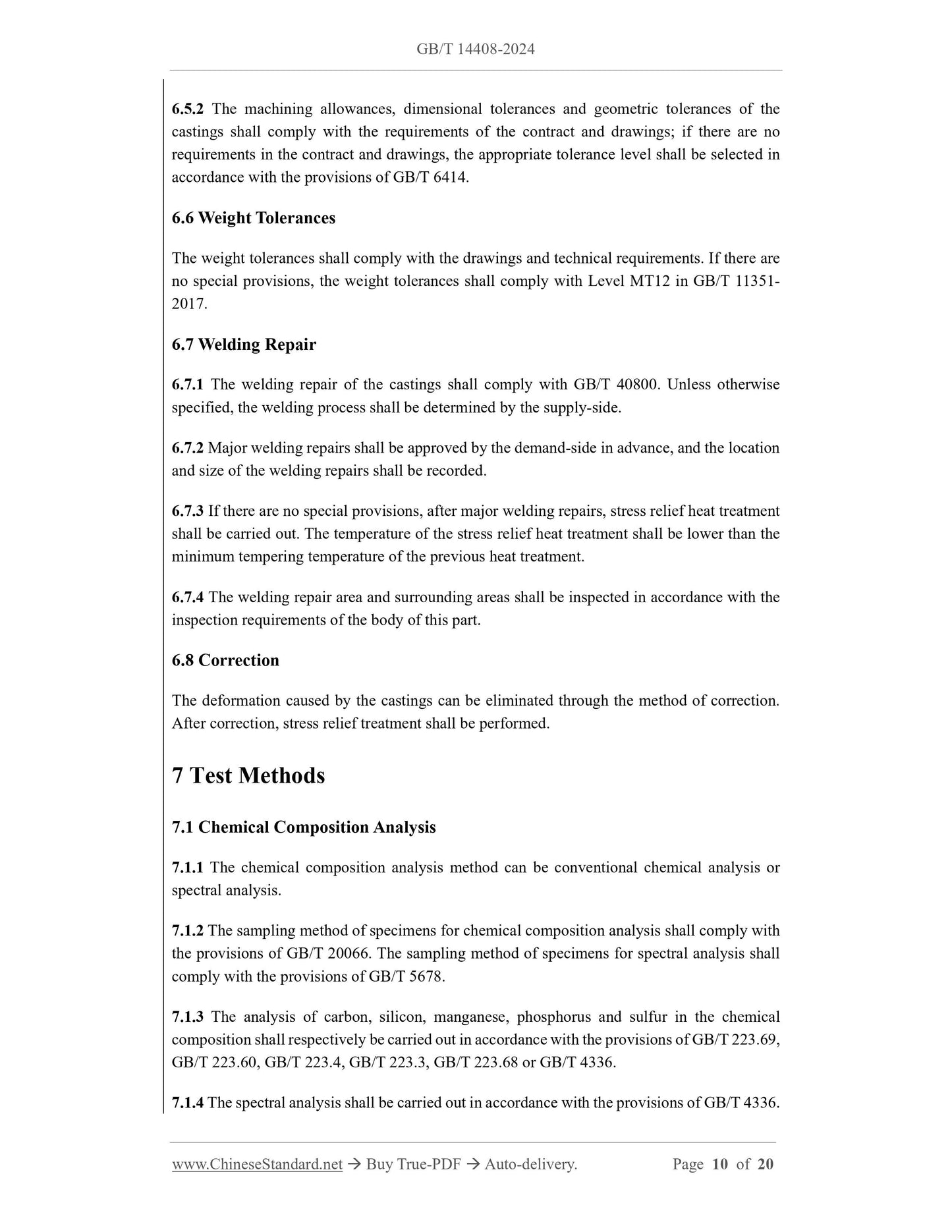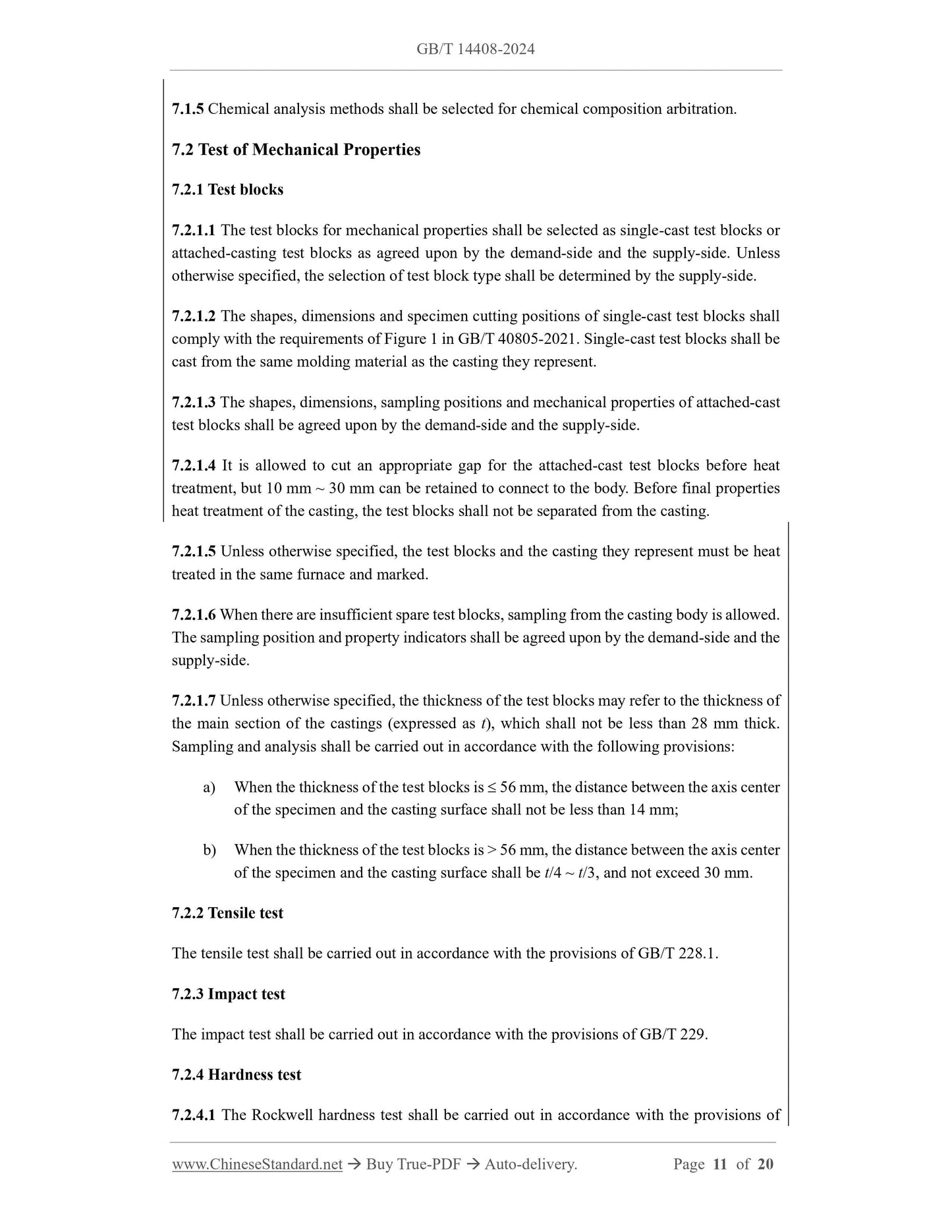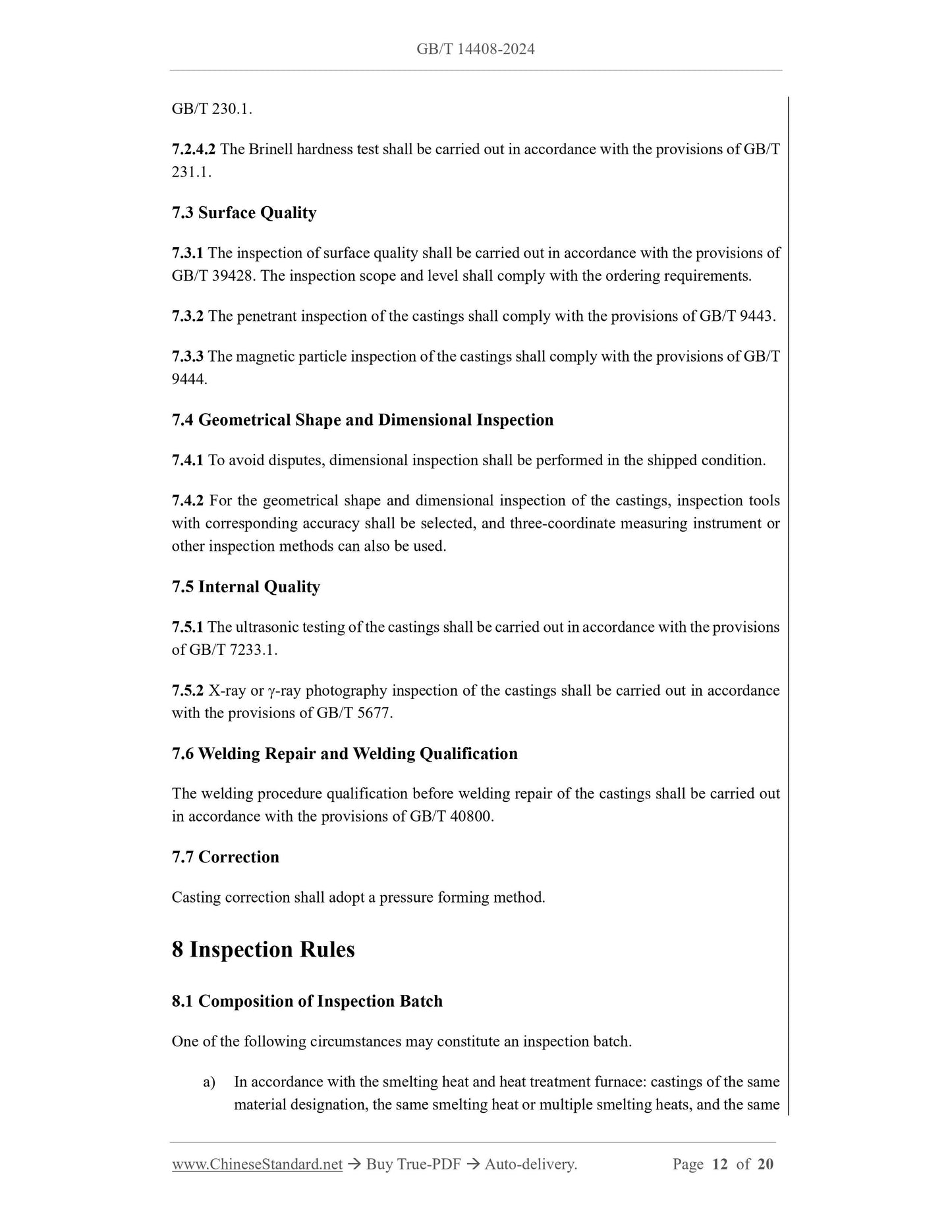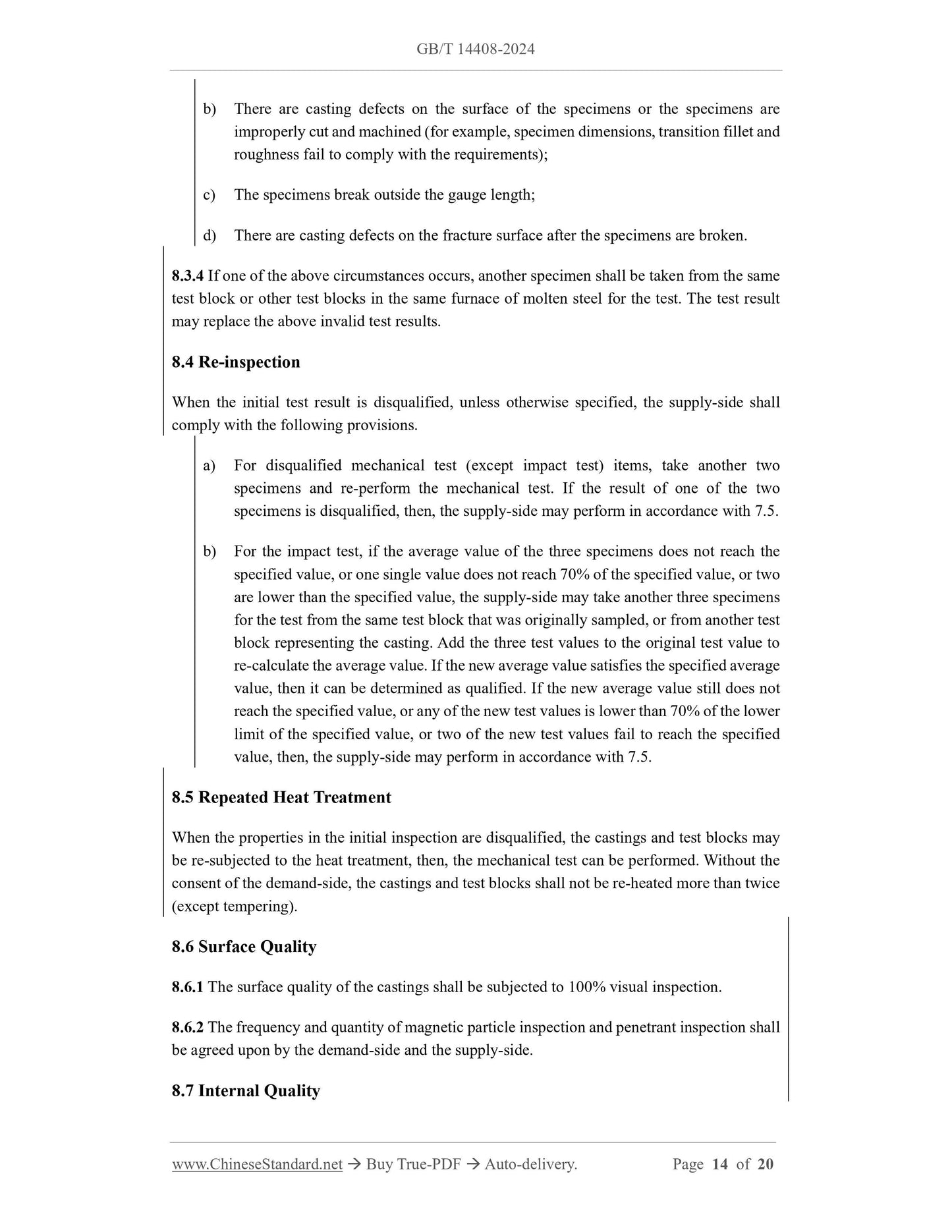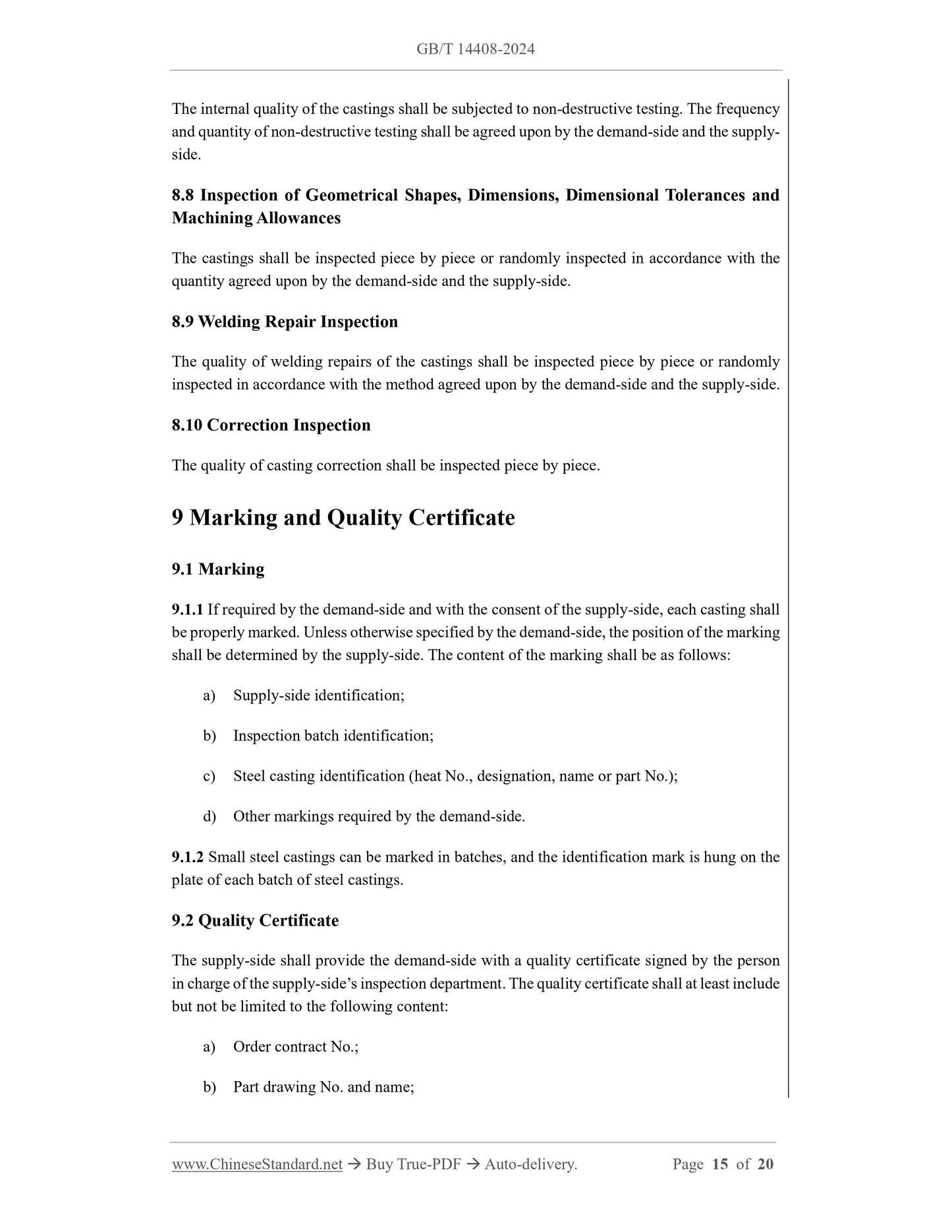1
/
de
10
PayPal, credit cards. Download editable-PDF and invoice in 1 second!
GB/T 14408-2024 English PDF (GBT14408-2024)
GB/T 14408-2024 English PDF (GBT14408-2024)
Prix habituel
$260.00 USD
Prix habituel
Prix promotionnel
$260.00 USD
Prix unitaire
/
par
Frais d'expédition calculés à l'étape de paiement.
Impossible de charger la disponibilité du service de retrait
Delivery: 3 seconds. Download true-PDF + Invoice.
Get QUOTATION in 1-minute: Click GB/T 14408-2024
Historical versions: GB/T 14408-2024
Preview True-PDF (Reload/Scroll if blank)
GB/T 14408-2024: Low alloy steel castings for general engineering and structural purposes
GB/T 14408-2024
GB
NATIONAL STANDARD OF THE
PEOPLE’S REPUBLIC OF CHINA
ICS 77.140.80
CCS J 31
Replacing GB/T 14408-2014
Low Alloy Steel Castings for General Engineering and
Structural Purposes
(ISO 9477:2023, High strength cast steels for general engineering and
structural purposes, MOD)
ISSUED ON: APRIL 25, 2024
IMPLEMENTED ON: APRIL 25, 2024
Issued by: State Administration for Market Regulation;
Standardization Administration of the People’s Republic of China.
Table of Contents
Foreword ... 3
1 Scope ... 5
2 Normative References ... 5
3 Terms and Definitions ... 6
4 General Conditions of Delivery ... 7
5 Manufacturing Process ... 7
6 Technical Requirements ... 7
7 Test Methods ... 10
8 Inspection Rules ... 12
9 Marking and Quality Certificate ... 15
10 Casting Protection, Packaging, Transportation and Storage ... 16
Appendix A (informative) Comparison of Structural No. between This Document and
ISO 9477:2023 ... 17
Appendix B (informative) Technical Differences between This Document and ISO
9477:2023 and the Causes ... 18
Bibliography ... 20
Low Alloy Steel Castings for General Engineering and
Structural Purposes
1 Scope
This document specifies the manufacturing, technical requirements, test methods, inspection
rules, marking and quality certificate of low alloy steel castings for general engineering and
structural purposes, as well as casting protection, packaging, transportation and storage, etc.
This document is applicable to the production, inspection and delivery acceptance of low alloy
steel castings for general engineering and structural purposes.
2 Normative References
The contents of the following documents constitute indispensable clauses of this document
through the normative references in the text. In terms of references with a specified date, only
versions with a specified date are applicable to this document. In terms of references without a
specified date, the latest version (including all the modifications) is applicable to this document.
GB/T 222 Permissible Tolerances for Chemical Composition of Steel Products
GB/T 223.3 Methods for Chemical Analysis of Iron, Steel and Alloy - The Diantipyryl Methane
Phosphomolybdate Gravimetric Method for the Determination of Phosphorus Content
GB/T 223.4 Alloyed Steel - Determination of Manganese Content - Potentiometric or Visual
Titration Method
GB/T 223.60 Methods for Chemical Analysis of Iron, Steel and Alloy - The Perchloric Acid
Dehydration Gravimetric Method for the Determination of Silicon Content
GB/T 223.68 Methods for Chemical Analysis of Iron, Steel and Alloy - The Potassium Iodate
Titration Method after Combustion in the Pipe Furnace for the Determination of Sulfur Content
GB/T 223.69 Iron, Steel and Alloy - Determination of Carbon Contents - Gas-volumetric
Method after Combustion in the Pipe Furnace
GB/T 228.1 Metallic Materials - Tensile Testing - Part 1: Method of Test at Room Temperature
GB/T 229 Metallic Materials - Charpy Pendulum Impact Test Method
GB/T 230.1 Metallic Materials - Rockwell Hardness Test - Part 1: Test Method
GB/T 231.1 Metallic Materials - Brinell Hardness Test - Part 1: Test Method
GB/T 4336 Carbon and Low-alloy Steel - Determination of Multi-element Contents - Spark
Discharge Atomic Emission Spectrometric Method (routine method)
GB/T 5611 Foundry Terminology
GB/T 5613 Designation for Cast Steels
GB/T 5677 Castings - Radiographic Testing
GB/T 5678 Sampling Methods of Spectrochemical Analysis for Cast Alloys
GB/T 6414 Castings - Dimensional Tolerances and Geometrical Tolerances and Machining
Allowances
GB/T 7233.1 Steel Castings - Ultrasonic Testing - Part 1: Steel Castings for General Purposes
GB/T 9443 Steel and Iron Castings - Liquid Penetrant Inspection
GB/T 9444 Steel and Iron Castings - Magnetic Particle Inspection
GB/T 11351-2017 Mass Tolerances of Casting
GB/T 20066 Steel and Iron - Sampling and Preparation of Samples for the Determination of
Chemical Composition
GB/T 39428 Steel Castings by Sand Casting - Visual Examination Method of Surface Quality
GB/T 40800 Specification and Qualification of Welding Procedures for Production Welding of
Steel Castings
GB/T 40805-2021 Steel Castings - General Technical Delivery Requirements
3 Terms and Definitions
The terms and definitions defined in GB/T 5611, and the following are applicable to this
document.
3.1 carbon equivalent
The content of alloying elements in steel is converted into the equivalent content of carbon in
accordance with their effects, which is equal to the sum of the converted carbon content of
various alloying elements and the actual total carbon content.
NOTE: carbon equivalent (CE) can be used as a reference index to evaluate the repair weldability
of steel. Unless otherwise specified, the carbon equivalent is generally calculated in
accordance with Formula (1).
Where,
C, Mn, Cr, Mo, V, Ni, Cu---the mass fraction of the element in steel, expressed in (%).
[source: GB/T 37681-2019, 3.10]
3.2 major defect
A defect with an excavation depth exceeding 25 mm or 40% of the wall thickness (whichever
is smaller) or an excavation repair area greater than 64 cm2.
4 General Conditions of Delivery
4.1 The delivered products shall comply with the requirements stated in the ordering
information and additional materials in GB/T 40805-2021.
4.2 The supplementary requirements for delivered products shall be determined in the order
contract, and the specific requirements shall comply with the provisions of Appendix C in GB/T
40805-2021.
5 Manufacturing Process
5.1 Casting
5.1.1 Unless the demand-side has special requirements, the smelting method of alloy materials
shall be determined by the supply-side.
5.1.2 Unless the demand-side has special requirements, the casting and forming processes and
methods shall be determined by the supply-side.
5.2 Heat Treatment
Unless the demand-side has special requirements, the heat treatment process shall be
determined by the supply-side.
6 Technical Requirements
6.1 Chemical Composition
6.1.1 The method of designation expression of low alloy steel castings shall comply with the
provisions of GB/T 5613.
6.1.2 The sulfur and phosphorus contents in the chemical composition of each material
designation shall comply with the provisions of Table 1.
6.5.2 The machining allowances, dimensional tolerances and geometric tolerances of the
castings shall comply with the requirements of the contract and drawings; if there are no
requirements in the contract and drawings, the appropriate tolerance level shall be selected in
accordance with the provisions of GB/T 6414.
6.6 Weight Tolerances
The weight tolerances shall comply with the drawings and technical requirements. If there are
no special provisions, the weight tolerances shall comply with Level MT12 in GB/T 11351-
2017.
6.7 Welding Repair
6.7.1 The welding repair of the castings shall comply with GB/T 40800. Unless otherwise
specified, the welding process shall be determined by the supply-side.
6.7.2 Major welding repairs shall be approved by the demand-side in advance, and the location
and size of the welding repairs shall be recorded.
6.7.3 If there are no special provisions, after major welding repairs, stress relief heat treatment
shall be carried out. The temperature of the stress relief heat treatment shall be lower than the
minimum tempering temperature of the previous heat treatment. <...
Get QUOTATION in 1-minute: Click GB/T 14408-2024
Historical versions: GB/T 14408-2024
Preview True-PDF (Reload/Scroll if blank)
GB/T 14408-2024: Low alloy steel castings for general engineering and structural purposes
GB/T 14408-2024
GB
NATIONAL STANDARD OF THE
PEOPLE’S REPUBLIC OF CHINA
ICS 77.140.80
CCS J 31
Replacing GB/T 14408-2014
Low Alloy Steel Castings for General Engineering and
Structural Purposes
(ISO 9477:2023, High strength cast steels for general engineering and
structural purposes, MOD)
ISSUED ON: APRIL 25, 2024
IMPLEMENTED ON: APRIL 25, 2024
Issued by: State Administration for Market Regulation;
Standardization Administration of the People’s Republic of China.
Table of Contents
Foreword ... 3
1 Scope ... 5
2 Normative References ... 5
3 Terms and Definitions ... 6
4 General Conditions of Delivery ... 7
5 Manufacturing Process ... 7
6 Technical Requirements ... 7
7 Test Methods ... 10
8 Inspection Rules ... 12
9 Marking and Quality Certificate ... 15
10 Casting Protection, Packaging, Transportation and Storage ... 16
Appendix A (informative) Comparison of Structural No. between This Document and
ISO 9477:2023 ... 17
Appendix B (informative) Technical Differences between This Document and ISO
9477:2023 and the Causes ... 18
Bibliography ... 20
Low Alloy Steel Castings for General Engineering and
Structural Purposes
1 Scope
This document specifies the manufacturing, technical requirements, test methods, inspection
rules, marking and quality certificate of low alloy steel castings for general engineering and
structural purposes, as well as casting protection, packaging, transportation and storage, etc.
This document is applicable to the production, inspection and delivery acceptance of low alloy
steel castings for general engineering and structural purposes.
2 Normative References
The contents of the following documents constitute indispensable clauses of this document
through the normative references in the text. In terms of references with a specified date, only
versions with a specified date are applicable to this document. In terms of references without a
specified date, the latest version (including all the modifications) is applicable to this document.
GB/T 222 Permissible Tolerances for Chemical Composition of Steel Products
GB/T 223.3 Methods for Chemical Analysis of Iron, Steel and Alloy - The Diantipyryl Methane
Phosphomolybdate Gravimetric Method for the Determination of Phosphorus Content
GB/T 223.4 Alloyed Steel - Determination of Manganese Content - Potentiometric or Visual
Titration Method
GB/T 223.60 Methods for Chemical Analysis of Iron, Steel and Alloy - The Perchloric Acid
Dehydration Gravimetric Method for the Determination of Silicon Content
GB/T 223.68 Methods for Chemical Analysis of Iron, Steel and Alloy - The Potassium Iodate
Titration Method after Combustion in the Pipe Furnace for the Determination of Sulfur Content
GB/T 223.69 Iron, Steel and Alloy - Determination of Carbon Contents - Gas-volumetric
Method after Combustion in the Pipe Furnace
GB/T 228.1 Metallic Materials - Tensile Testing - Part 1: Method of Test at Room Temperature
GB/T 229 Metallic Materials - Charpy Pendulum Impact Test Method
GB/T 230.1 Metallic Materials - Rockwell Hardness Test - Part 1: Test Method
GB/T 231.1 Metallic Materials - Brinell Hardness Test - Part 1: Test Method
GB/T 4336 Carbon and Low-alloy Steel - Determination of Multi-element Contents - Spark
Discharge Atomic Emission Spectrometric Method (routine method)
GB/T 5611 Foundry Terminology
GB/T 5613 Designation for Cast Steels
GB/T 5677 Castings - Radiographic Testing
GB/T 5678 Sampling Methods of Spectrochemical Analysis for Cast Alloys
GB/T 6414 Castings - Dimensional Tolerances and Geometrical Tolerances and Machining
Allowances
GB/T 7233.1 Steel Castings - Ultrasonic Testing - Part 1: Steel Castings for General Purposes
GB/T 9443 Steel and Iron Castings - Liquid Penetrant Inspection
GB/T 9444 Steel and Iron Castings - Magnetic Particle Inspection
GB/T 11351-2017 Mass Tolerances of Casting
GB/T 20066 Steel and Iron - Sampling and Preparation of Samples for the Determination of
Chemical Composition
GB/T 39428 Steel Castings by Sand Casting - Visual Examination Method of Surface Quality
GB/T 40800 Specification and Qualification of Welding Procedures for Production Welding of
Steel Castings
GB/T 40805-2021 Steel Castings - General Technical Delivery Requirements
3 Terms and Definitions
The terms and definitions defined in GB/T 5611, and the following are applicable to this
document.
3.1 carbon equivalent
The content of alloying elements in steel is converted into the equivalent content of carbon in
accordance with their effects, which is equal to the sum of the converted carbon content of
various alloying elements and the actual total carbon content.
NOTE: carbon equivalent (CE) can be used as a reference index to evaluate the repair weldability
of steel. Unless otherwise specified, the carbon equivalent is generally calculated in
accordance with Formula (1).
Where,
C, Mn, Cr, Mo, V, Ni, Cu---the mass fraction of the element in steel, expressed in (%).
[source: GB/T 37681-2019, 3.10]
3.2 major defect
A defect with an excavation depth exceeding 25 mm or 40% of the wall thickness (whichever
is smaller) or an excavation repair area greater than 64 cm2.
4 General Conditions of Delivery
4.1 The delivered products shall comply with the requirements stated in the ordering
information and additional materials in GB/T 40805-2021.
4.2 The supplementary requirements for delivered products shall be determined in the order
contract, and the specific requirements shall comply with the provisions of Appendix C in GB/T
40805-2021.
5 Manufacturing Process
5.1 Casting
5.1.1 Unless the demand-side has special requirements, the smelting method of alloy materials
shall be determined by the supply-side.
5.1.2 Unless the demand-side has special requirements, the casting and forming processes and
methods shall be determined by the supply-side.
5.2 Heat Treatment
Unless the demand-side has special requirements, the heat treatment process shall be
determined by the supply-side.
6 Technical Requirements
6.1 Chemical Composition
6.1.1 The method of designation expression of low alloy steel castings shall comply with the
provisions of GB/T 5613.
6.1.2 The sulfur and phosphorus contents in the chemical composition of each material
designation shall comply with the provisions of Table 1.
6.5.2 The machining allowances, dimensional tolerances and geometric tolerances of the
castings shall comply with the requirements of the contract and drawings; if there are no
requirements in the contract and drawings, the appropriate tolerance level shall be selected in
accordance with the provisions of GB/T 6414.
6.6 Weight Tolerances
The weight tolerances shall comply with the drawings and technical requirements. If there are
no special provisions, the weight tolerances shall comply with Level MT12 in GB/T 11351-
2017.
6.7 Welding Repair
6.7.1 The welding repair of the castings shall comply with GB/T 40800. Unless otherwise
specified, the welding process shall be determined by the supply-side.
6.7.2 Major welding repairs shall be approved by the demand-side in advance, and the location
and size of the welding repairs shall be recorded.
6.7.3 If there are no special provisions, after major welding repairs, stress relief heat treatment
shall be carried out. The temperature of the stress relief heat treatment shall be lower than the
minimum tempering temperature of the previous heat treatment. <...
Share
